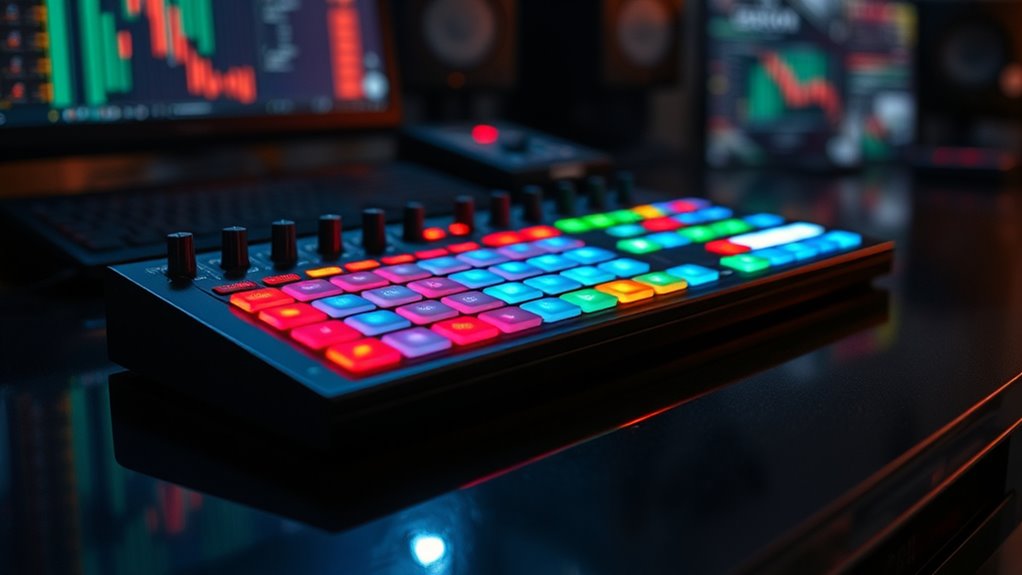Chance operations let you add controlled randomness to your MIDI sequences by assigning probabilities to notes, rhythms, and parameters. With this approach, you can create dynamic, unpredictable patterns that still feel cohesive, enhancing your compositions with organic variations. Using tools like DAW features or scripting, you can tweak these probabilities to balance surprise and musicality. Keep exploring to discover how these techniques can release fresh sonic possibilities and inspire your creativity.
Key Takeaways
- Chance operations use probabilistic parameters to introduce controlled randomness in MIDI note selection and timing.
- They enable dynamic, evolving musical patterns by varying pitches, rhythms, and velocities within set ranges.
- Modern DAWs and plugins incorporate tools for applying stochastic processes to generate unpredictable yet cohesive sounds.
- By adjusting probability settings, composers can balance randomness with musical structure and artistic intent.
- This technique fosters creativity, improvisation, and exploration of new sonic textures in digital music production.

Chance operations refer to creative processes that rely on randomness or unpredictable factors to generate art or ideas. When it comes to MIDI and digital music production, these methods can introduce a fascinating layer of spontaneity, allowing you to step beyond traditional composition. By utilizing probabilistic composition, you can craft music that feels organic, dynamic, and full of surprises. Instead of meticulously programming every note, you set parameters and let stochastic processes determine the outcome. This approach creates a controlled form of randomness, where the unpredictability is harnessed within defined boundaries, giving you both freedom and structure.
Using probabilistic composition in MIDI involves assigning probabilities to notes, rhythms, or parameters. For example, you might designate that a certain note has a 30% chance of playing at each iteration, or that a particular drum pattern varies within a set range. This method taps into stochastic processes—mathematical models that describe systems evolving randomly over time—to generate variations that feel both natural and intentional. By adjusting probabilities, you influence the overall mood and complexity of your piece, creating variations that can evolve organically or remain consistent, depending on your goals. Additionally, understanding the importance of contrast ratio in audio and visual quality can help you fine-tune the output for more immersive experiences.
Implementing chance operations in MIDI is straightforward with modern digital audio workstations (DAWs) and plugins that support randomness. You can use built-in features like probability controls, random generators, or scripting tools to automate the process. For instance, a sequencer might randomly select pitches or rhythms within a scale, or modulate parameters like velocity and duration based on stochastic algorithms. This allows you to experiment with different configurations effortlessly, discovering new musical ideas without the constraints of manual programming. It’s like giving your composition a set of rules, then stepping back to see what emerges.
The power of chance operations lies in their ability to foster creativity and break through writer’s block. By trusting stochastic processes, you allow the music to unfold in unpredictable ways, often leading to fresh, unexpected results. This technique is especially useful for creating textures, generative soundscapes, or improvisational-sounding parts that still feel cohesive. It encourages you to focus on the overall structure and mood while leaving room for surprises within each iteration. As you gain experience, you’ll learn to fine-tune probabilities and parameters, balancing randomness with musicality.
In essence, chance operations in MIDI provide a controlled environment for randomness, blending mathematical precision with artistic intuition. They empower you to explore new sonic territories, generate complex patterns, and develop unique compositions without sacrificing control. By harnessing probabilistic composition and stochastic processes, you transform randomness from a barrier into a powerful creative tool, opening up endless possibilities for innovative music.
Frequently Asked Questions
How Can Chance Operations Influence Emotional Expression in Music?
Chance operations influence emotional expression by introducing emotional unpredictability and expressive variability into your music. When you use controlled randomness, you allow unexpected sounds and rhythms to emerge, creating a sense of spontaneity that resonates emotionally. This technique helps you break free from rigid patterns, making your compositions feel more alive and genuine. Embracing these elements adds depth and complexity, making your music more engaging and emotionally compelling for your audience.
What Are Common Software Tools for Implementing Chance Operations?
Did you know that over 60% of modern composers experiment with chance operations? You can use software platforms like Max/MSP, Pure Data, or Ableton Live to implement random algorithms easily. These tools allow you to generate controlled randomness, helping you craft unpredictable yet emotionally resonant music. With these platforms, you can explore new creative boundaries and infuse your compositions with spontaneous energy that resonates deeply with listeners.
Can Chance Operations Be Combined With Traditional Composition Techniques?
Yes, you can blend chance operations with traditional composition techniques by using aleatoric blending, where randomness complements structured elements. You might incorporate improvisational integration, allowing performers to introduce spontaneous variations within a composed framework. This approach creates a dynamic interplay, enriching your music with unexpected nuances while maintaining your core musical ideas. Combining these methods offers a versatile way to explore new textures and expressive possibilities in your compositions.
How Do Performers Interpret Music Created With Chance Methods?
You interpret music created with chance methods through your improvisation techniques and performer improvisation skills. Embrace the unpredictability, listening closely to the generated material, and respond intuitively. You might emphasize certain motifs or explore new textures, allowing the randomness to guide your expression. This approach encourages spontaneity, making each performance unique and deeply personal, as you engage with the music’s controlled chaos and shape it through your improvisational instincts.
Are There Famous Composers Known for Using Chance Operations Extensively?
You’ll find that John Cage is the most famous composer known for extensively using chance operations and aleatoric techniques. He pioneered the incorporation of randomness into music, allowing performers to interpret pieces uniquely each time. Cage’s innovative approach challenged traditional composition, inspiring many others to explore controlled randomness. His works like “Music of Changes” exemplify how chance can generate compelling, unpredictable soundscapes, making him a pivotal figure in this experimental domain.
Conclusion
Embrace chance operations and let controlled randomness breathe new life into your music. Think of it as opening a door to endless creative possibilities, where surprises become your greatest allies. Don’t shy away from the unpredictable; instead, dance with it, and watch your compositions transform into vibrant, living art. After all, isn’t it in the chaos that true beauty often hides, waiting to be uncovered by those bold enough to explore?










